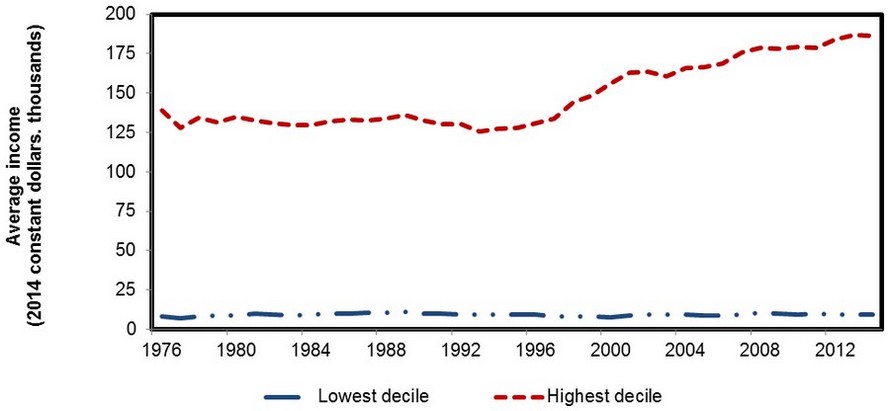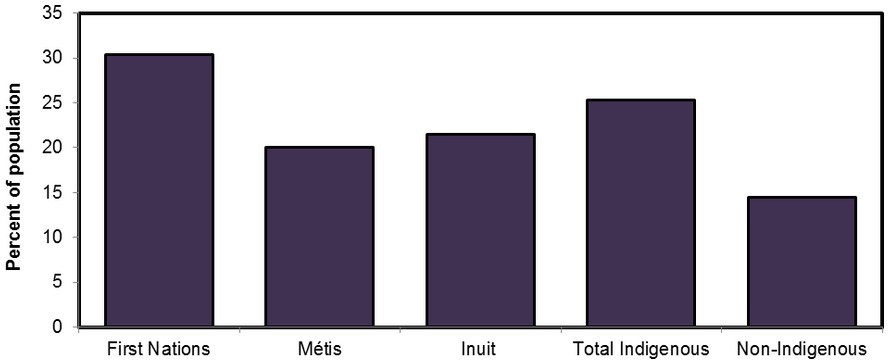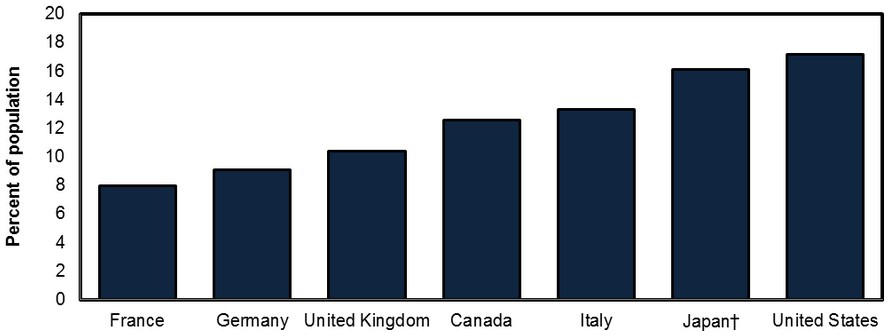Health Status of Canadians 2016: Report of the Chief Public Health Officer - What is influencing our health? - Income
What is influencing our health?
Income
In 2014, the average household income after taxes was $68,000.Footnote 1 Just under 5 million or just over 1 in 10 Canadians were living in low-income households (see Figure 1)Footnote 2.

For this section, low income is considered as any income that is less than half of a country's average income, calculated after taxes and transfers.Footnote 2,Footnote 8 Income influences people's health and is an important predictor of health outcomes, such as life expectancy and risk for some diseases.Footnote 3-7
Over time
The proportion of Canadians living in low income has fluctuated from 13% in 1976 to 11% in 1989 and back to 13% in 2014.Footnote 8 The gap between those with the highest and lowest incomes has been growing (see Figure 2)Footnote 9.

Deciles are calculated by dividing the Canadian population into ten groups of equal size (deciles) based on income.
Text Equivalent
Line chart showing average income after taxes in those living in the highest and lowest incomes levels from 1976 to 2014. These data are divided into income deciles. Deciles are calculated by dividing the Canadian population into ten groups of equal size (deciles) based on neighbourhood income.
Lowest decile
- 1976 = $8,300
- 1982 = $9,500
- 1988 = $10,700
- 1994 = $9,500
- 2002 = $9,300
- 2008 = $10,500
- 2014 = $9,300
Highest decile
- 1976 = $139,300
- 1982 = $131,000
- 1988 = $133,500
- 1994 = $127,200
- 2002 = $163,400
- 2008 = $178,500
- 2014 = $186,500
By sex
In the past, men were less likely to have a low income than women. More recently, men and women were equally likely to have a low income.Footnote 2
| 1976 | 2014 | |
|---|---|---|
| Men | 12% | 13% |
| Women | 15% | 14% |
By age
The proportion of older Canadians who have a low income has decreased from 31% in 1976 to 13% in 2013. Other age groups have seen a slight increase.Footnote 2
| Age group | 1976 | 2014 |
|---|---|---|
| Under 18 years | 14% | 15% |
| 18 to 64 years | 10% | 13% |
| 65 years and older | 31% | 13% |
Indigenous populations
Data on income in Indigenous populations are not directly comparable to the data described above. Comparable data show that Indigenous populations, particularly First Nations at just over 30%, were more likely to have a low income than non-Indigenous populations at just under 15% (see Figure 3)Footnote 10.

Text Equivalent
Bar chart showing the percent of Canadians living low income in 2011.
- First Nations : 30.4%
- Métis : 20%
- Inuit : 21.5%
- Total Indigenous: 25.3%
- Non-Indigenous: 14.5%
International comparison
In 2013, the proportion of people living with a low income was highest in the United States at just under 18% and lowest in France at 8%. Canada ranked in the middle of G7 countries at just under 13% (see Figure 4)Footnote 11.

† For Japan: data for 2012
Text Equivalent
Bar graphs showing the percent of people living in poverty in G7 countries in 2013.
- Canada = 12.6%
- United States = 17.2%
- United Kingdom = 10.4%
- France = 8.0%
- Germany = 9.1%
- Italy = 13.3%
- Japan = 16.1%
Notes to the reader
- Indigenous populations consist of First Nations, Métis and Inuit.
- The data on Indigenous populations have not been adjusted for their high cost of living, meaning gaps may not accurately represent reality.
- G7 countries include seven of the world's industrialized countries, namely the United States, Japan, Germany, France, the United Kingdom, Italy and Canada, that form an informal discussion group and economic partnership.